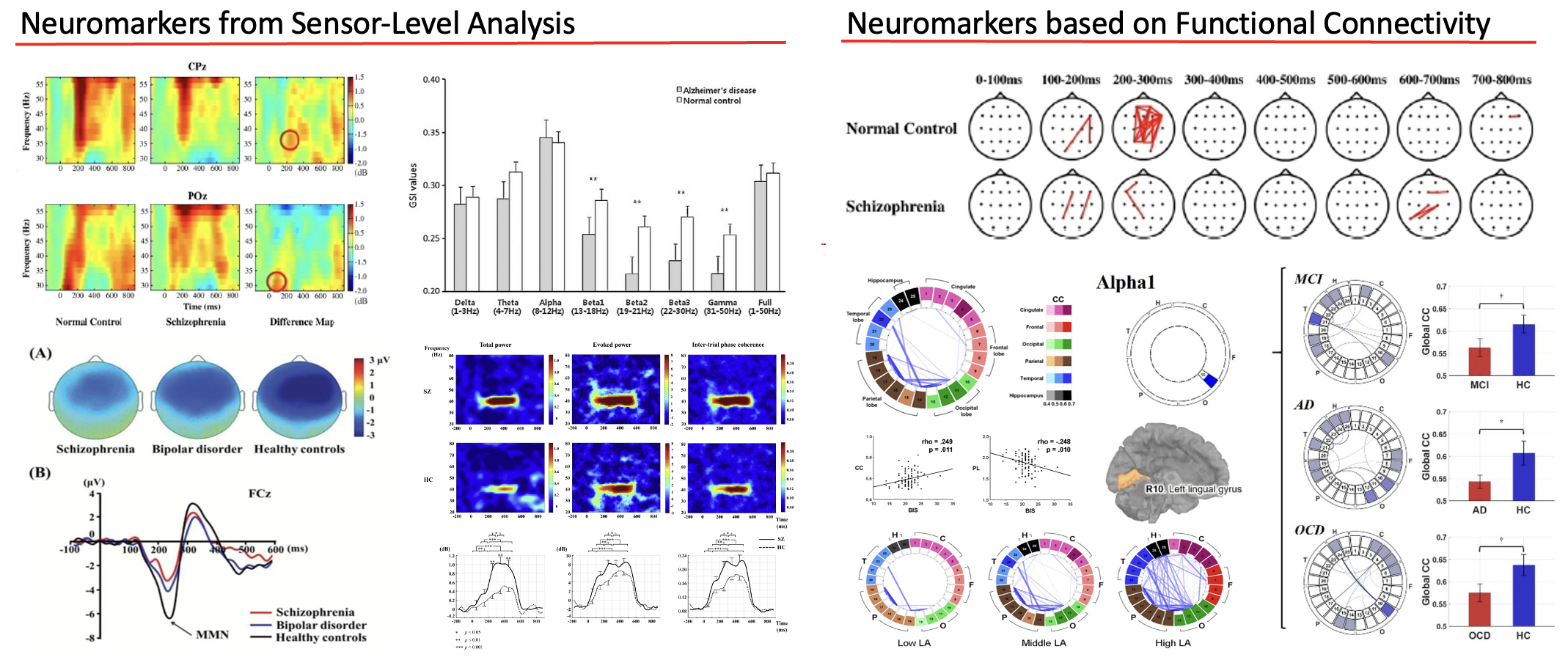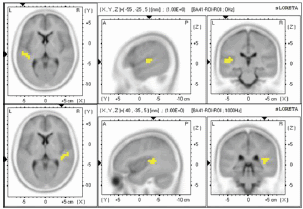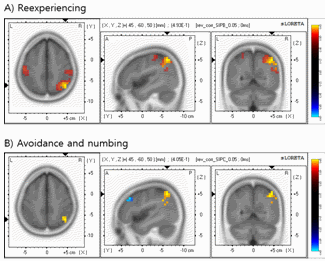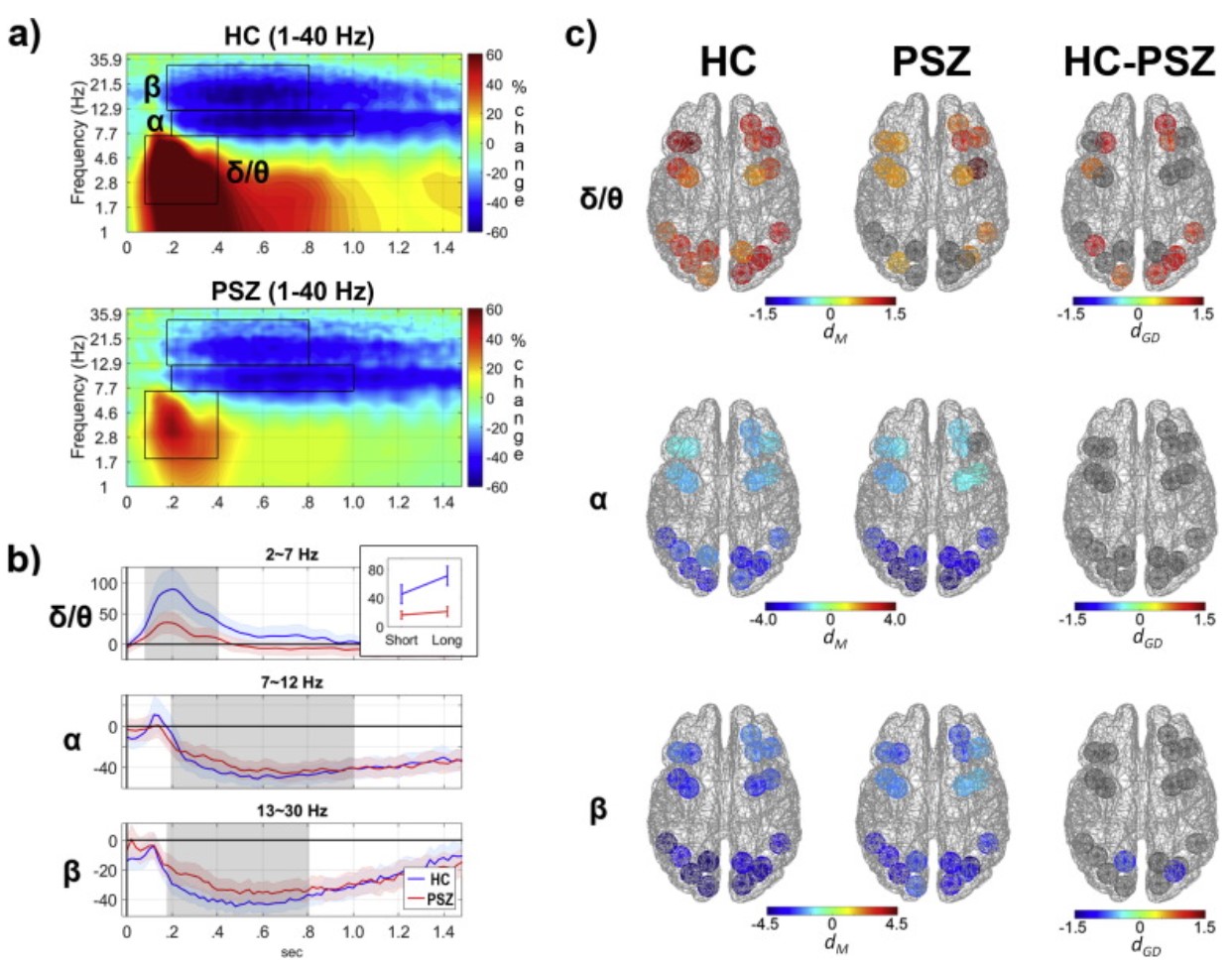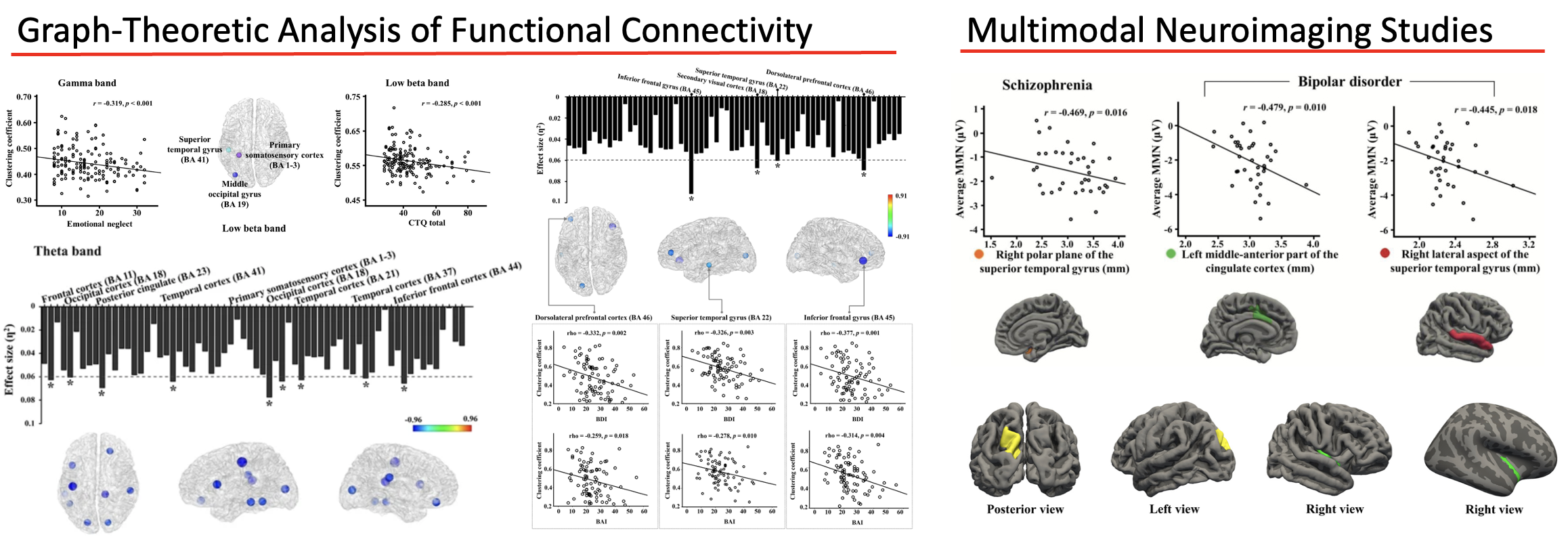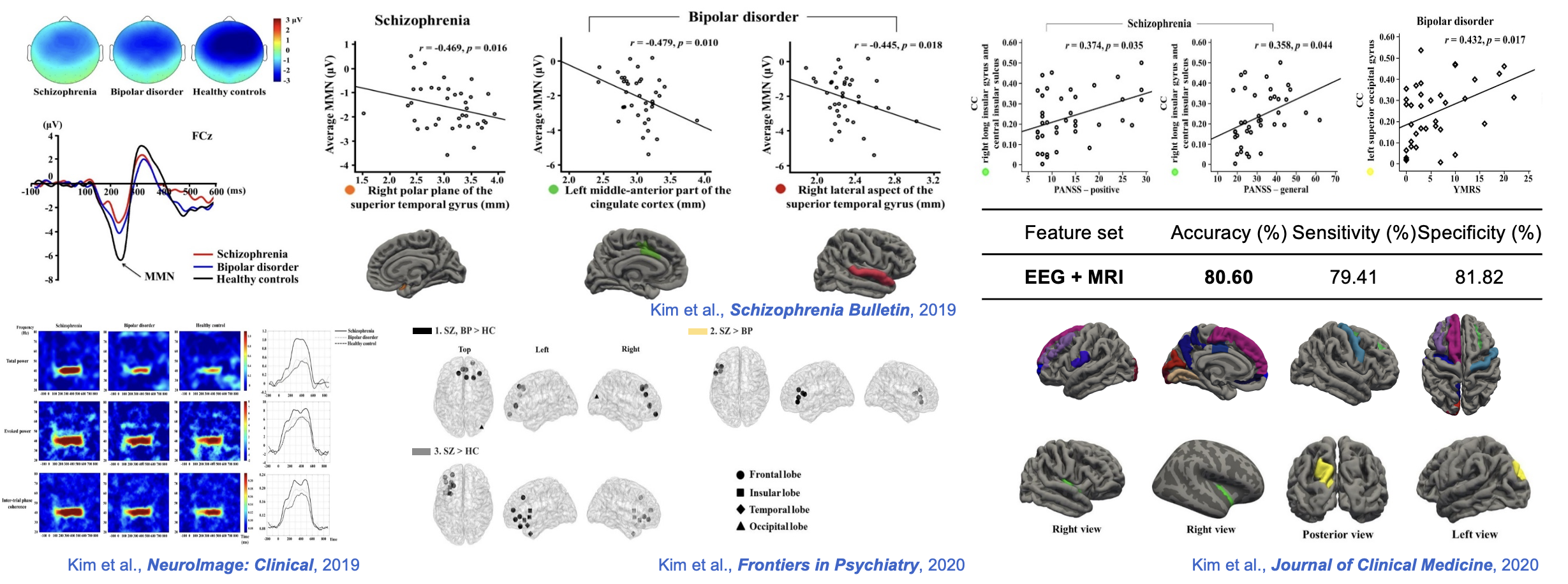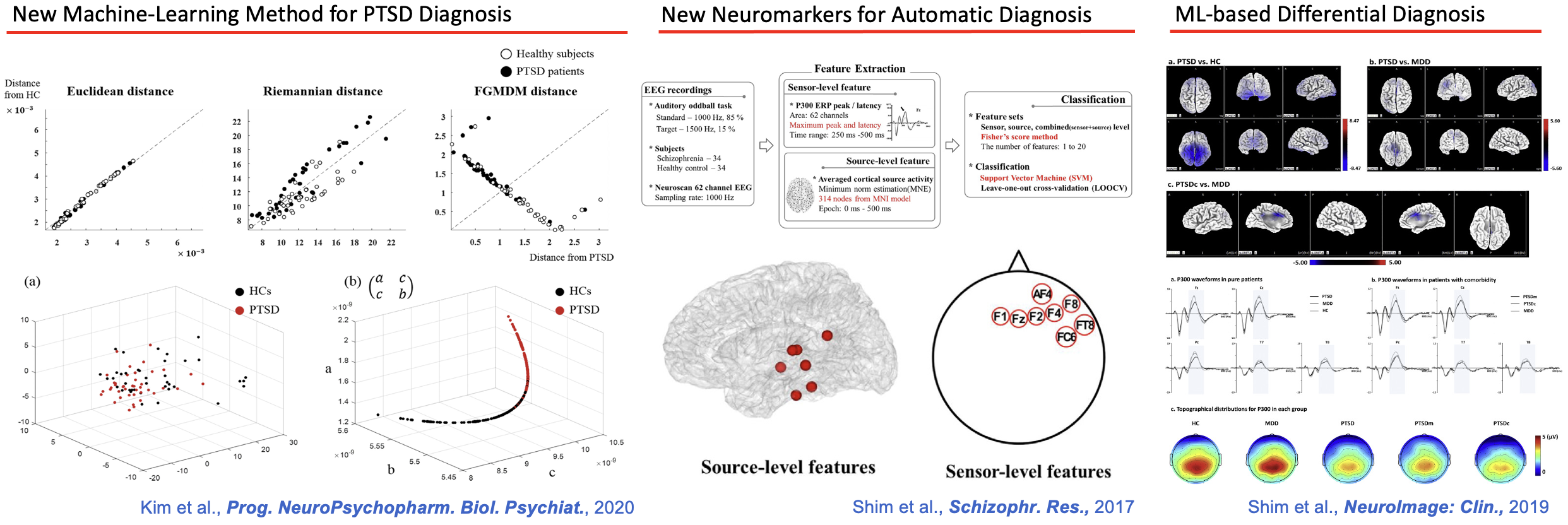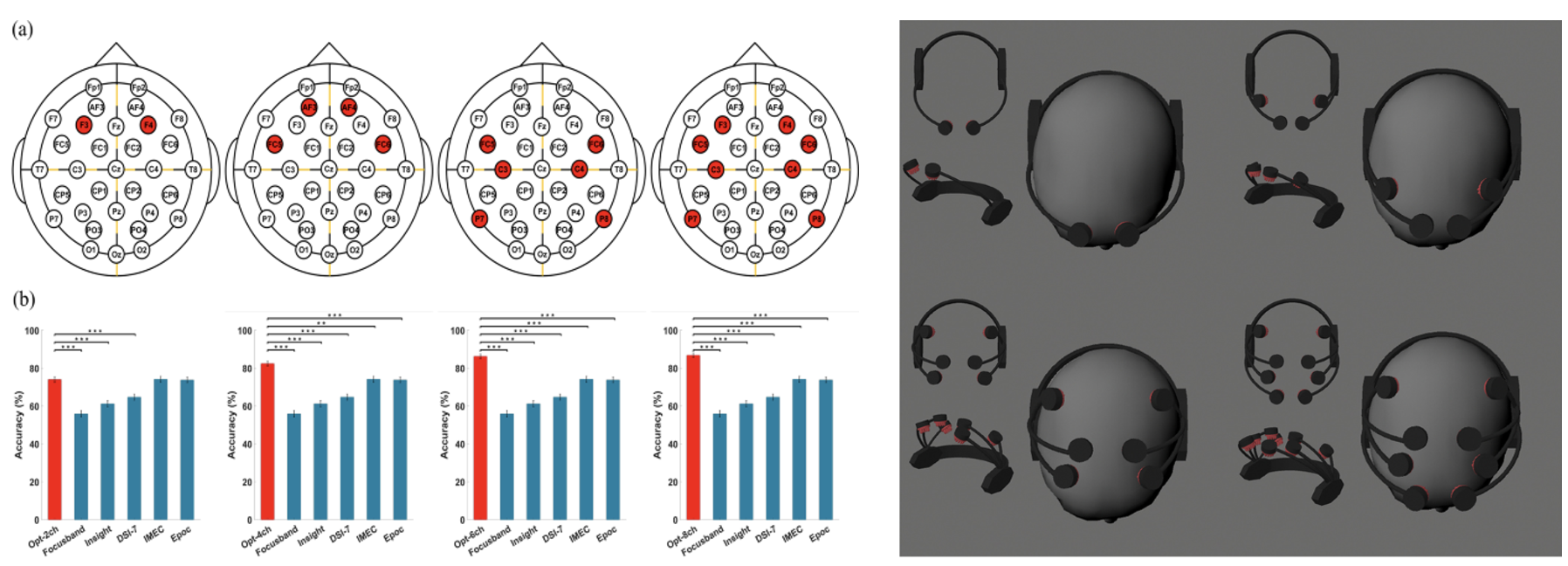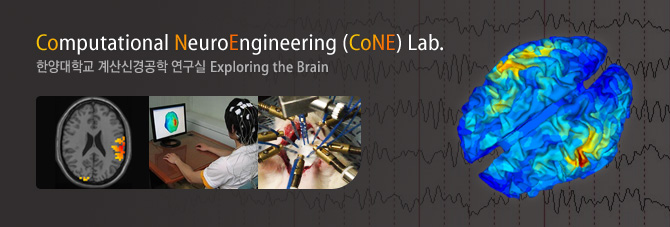
본문내용
Research Topics
EEG-Based Diagnosis of Psychiatric Diseases and Digitial Healthcare: 뇌파 기반 디지털 헬스케어
|
현대 사회와 신경정신 질환 고령화, 산업화 사회의 도래로 인해 각종 신경정신 질환으로 고통 받는 환자의 수가 급격히 증가하고 있으나 이들 질환에 대한 객관적이고 정량적인 진단, 특히 조기 진단은 매우 어려운 상황이다. 우울증, 조현병, 알츠하이머병-치매, 외상후 스트레스 장애, 뇌졸중, 자폐, 주의력 결핍 과잉행동 장애, 공황장애, 범불안장애 등등 이루 헤아릴 수 없을 만큼 많은 마음의 병이 있고 이 마음의 병의 근원은 바로 고장난 뇌에 있다. 하지만 아직까지도 이들 질환의 진단은 설문지 등을 이용한 문진에 크게 의존하고 있으며 발생 기전이 명확하게 규명되지 않은 질환들도 다수 존재한다. 더욱 심각한 문제는 이와 같은 신경정신 질환들의 대부분이 치료가 매우 어렵다는 점이며, 조기에 정확한 진단을 통해서만 치료가 가능한 경우가 많다. 최근 고령화 사회의 도래로 인해 특히 사회적 문제가 되고 있는 치매의 경우, 조기에 진단을 할 경우에는 약물 치료를 통해 진행 속도를 늦출 수 있으나 단순한 노령화에 의한 기억력이나 인지의 감소 정도로 생각하고 방치하였을 경우, 되돌릴 수 없는 결과를 초래할 수도 있다. 실제로 알츠하이머병은 65세 이상 노인 1백명 중 1명 꼴로 발생하고 그 후로는 5년이 지날 때마다 발병률이 2배씩 증가하는데, 최근 우리나라도 고령화 사회에 접어들게 됨에 따라 치매, 알츠하이머병에 대한 심각성이 사회 문제화 되고 있다. 참고로 알츠하이머병은 노인성 우울증 등과의 구별이 매우 어려우며 조기 진단을 위한 기술이 아직 확립되어 있지 않은 상황이다. 본 연구실에서는 상기의 다양한 신경정신 질환들을 뇌파, 뇌자도, 근적외선 분광, 자기공명영상 등과 같은 다양한 뇌신호 측정 시스템을 활용하여 객관적인 조기 진단을 가능하게 하는 공학적인 기술들을 개발하는 것을 목표로 임상의학계와의 공동 연구를 활발히 수행하고 있다. 또한 뇌파를 비롯한 생체신호 기반의 디지털 헬스케어 솔루션을 개발하기 위한 연구도 기업체와의 협력을 통해 진행하고 있다. 아래에는 본 연구실의 연구 결과 중 일부를 정리하였다. 2020년 이후 종료된 뇌파 기반 정신질환 진단 및 디지털 헬스케어 관련 연구과제 목록
뇌파 신호의 다중 분석을 통한 신경정신 질환의 객관적 진단 지표(뉴로마커) 추출 계산지능 및 뇌공학 연구실에서는 인제대학교 백병원 이승환 교수님 연구팀과 공동으로 뇌파 데이터를 기반으로 한 알츠하이머 치매, 조현병, 외상후 스트레스 장애, 양극성 장애, 주요 우울장애 등 다양한 정신질환의 객관적이고 정량화된 진단 기술을 개발하고 있다. 이처럼 뇌파 등 생체신호를 이용하여 추출한 정량적 진단 지표를 뉴로마커(Neuromarker)라고 통칭하는데, 본 연구실에서는 현존하는 모든 종류의 뉴로마커를 구현하고 적용해 왔을 뿐만 아니라 새로운 분석 방법을 개발하여 기존의 뉴로마커의 성능을 보다 개선한 새로운 뉴로마커를 다수 개발하여 발표하고 있다. 아래 그림은 본 연구실에서 다양한 정신질환의 진단을 위해 개발한 센서 수준의 뉴로마커와 기능적 연결성 기반의 뉴로마커 적용 사례를 보여주고 있다.
<본 연구실에서 개발한 다양한 뉴로마커의 정신질환 임상 뇌파 데이터 적용 사례>
뇌파 신호원 영상을 이용한 신경정신 질환의 메커니즘 규명 본 연구실에서는 LORETA나 SPM과 같은 뇌파 신호원 영상 기술들을 활용하여 다양한 신경정신 질환의 발병 메커니즘을 규명하고 나아가 이를 진단에 활용하기 위한 연구들을 수행하고 있다. 아래 왼쪽 그림은 범불안장애(Generalized anxiety disorder) 환자를 대상으로 한 청각유발전위 실험에서 sLORETA 결과의 소리 자극 크기에 대한 의존도가 Hamilton Anxiety Rating Scale과 높은 상관성을 보임을 보고한 결과 중 일부로서 범불안장애 환자의 치료 예후를 예측하기 위한 지표를 제시하였다는 중요한 의의를 가진다. 아래 가운데 그림은 외상후 스트레스 증후군(Post-traumatic stress disorder: PTSD) 환자와 정상인 사이에 P300 ERP 성분에서의 뇌 신호원 분포를 비교한 결과 중 일부로서 다양한 신경망 및 신경활동이 PTSD의 증상 특성에 기여한다는 사실을 보였으며 PTSD 환자의 뇌 활동 변화를 이해하기 위한 단서를 제공하였다는 의의를 가진다. 아래 오른쪽 그림은 미국 University of Minnesota 정신과와 공동연구를 수행한 결과로서 조현병 환자에게서 신호원 수준의 변화를 정량적으로 모니터링함으로써 조현병의 발병 메커니즘을 이해하기 위한 연구 결과이다. 이외에도 공황장애(panic disorder), 조현병(schizophrenia) 등 다양한 질환에서의 뇌파 신호원영상 분석 결과로부터 유용한 진단 지표를 찾아내기 위한 노력을 기울이고 있다.
<뇌파 신호원 영상 기술을 이용한 정신질환의 메커니즘 규명 연구 사례>
그래프 이론 기반 뇌 네트워크 정량화 및 다중모달 영상을 통한 정신질환 환자의 뇌 메커니즘 규명 한양대학교 계산지능 및 뇌공학 연구실에서는 뇌의 기능적 연결성 네트워크의 분석을 위해 사용되고 있는 그래프 이론(Graph Theory) 기반의 네트워크 정량화 측정 지표를 사용하여 조현병을 비롯한 다양한 질환군에서 정상인과 대비하여 연결성의 변화가 발생한다는 사실을 규명하였으며 이를 통해 정신질환의 진단에 활용이 가능한 새로운 뉴로마커를 다수 개발하였다 (왼쪽 아래 그림). 이 연구들에서 특히 뇌 영역 간 연결성 차이는 정신질환 환자의 증상 심각도와 높은 상관도를 나타내었는데 이는 뇌 영역 간의 연결성이 정신질환 진단의 중요한 진단 지표로 활용될 수 있음을 시사한다. 또한 본 연구실에서는 MRI 영상으로부터 피질 두께(cortical thickness)나 특정 뇌 영역의 부피 변화와 다양한 뇌파 기반 뉴로마커와의 상관도를 분석하거나 해부학적, 기능적 연결성 변화를 동시에 활용한 새로운 뉴로마커를 발굴하는 멀티모달 신경영상 연구도 수행하고 있다 (오른쪽 아래 그림)
<그래프 이론 기반의 뇌 네트워크 정량화를 통한 뉴로마커 발굴 및 멀티모달 신경영상 적용 사례>
유사 정신질환의 감별진단 및 치료 예후 예측을 위한 뉴로마커 발굴 한양대학교 계산지능 및 뇌공학 연구실에서는 증상의 유사성으로 인해 기존의 문진 및 설문조사 기반의 진단 방식으로 감별진단이 어려운 다양한 신경정신질환을 정량적으로 진단하기 위한 다양한 뉴로마커를 발굴하고 있으며 이와 동시에 약물 혹은 전자약을 통한 정신질환 치료의 효과를 사전에 예측할 수 있는 뉴로마커를 발굴하는 연구를 수행하고 있다. 아래 그림은 최근 5년 간 수행된 조현병(schizophrenia)과 양극성 장애(bipolar disorder) 환자의 감별진단을 위한 다양한 뉴로마커 탐색 및 기계학습을 이용한 자율진단 결과 사례를 보여주고 있으며 이 연구 이외에도 경도인지장애와 노인성 우울증의 감별진단, 양극성 장애와 주요우울장애의 감별진단 등과 같은 다양한 연구를 진행하고 있다.
<조현병과 양극성장애의 감별진단을 위한 멀티모달 뉴로마커 탐색 및 기계학습을 이용한 자율진단 적용 사례>
기계학습을 이용한 정신질환의 정량적 진단 기술 개발 한양대학교 계산지능 및 뇌공학 연구실에서는 기계학습(machine learning) 및 딥러닝(deep learning) 기술을 이용하여 다양한 정신질환을 보다 정량적으로 진단하기 위한 기술을 개발하고 있다. 아래는 본 연구실에서 수행한 정신질환(PTSD) 자율진단에 최초로 적용한 리만 기하학 기반의 분류 방법(왼쪽), 정신질환(조현병)의 자율진단을 위한 센서 수준-신호원 수준 복합 뉴로마커 개발(가운데), 외상후 스트레스 장애와 주요 우울장애의 감별진단을 위한 기계학습 적용 사례(오른쪽)를 예시로 보여주고 있다. 최근에는 조현병 이외에도 외상후 스트레스 증후군, 양극성장애 등의 컴퓨터 기반 진단 기술도 개발하고 있으며 딥러닝을 이용한 정신질환의 분류 및 예후 예측 연구도 수행하고 있다.
<계산지능 및 뇌공학 연구실에서 수행한 기계학습 기반의 정신질환 자율 진단 연구 사례>
일상 중 정신건강 모니터링을 위한 웨어러블 신경신호 측정 시스템의 설계 한양대학교 계산지능 및 뇌공학 연구실에서는 일상 중 정신건강의 모니터링과 정신질환의 스크리닝을 위한 웨어러블 신경신호 측정 시스템을 설계하고 설계한 시스템을 이용하여 소수의 채널에서 측정한 신경신호로부터 높은 진단 정확도를 도출할 수 있는 기계학습 기술을 개발하고 있다. 2022년에는 소수의 전극에서 측정한 뇌파로부터 경도인지장애를 가장 높은 정확도로 진단할 수 있는 웨어러블 뇌파 측정 시스템을 설계한 결과를 알츠하이머 치매 분야 최저명 학술지인 Alzheimer's Research & Therapy 지에 게재하기도 했다 (Lee et al., 2022; 아래 그림). 또한, 2020년부터 디지털 헬스케어 업체인 (주)비웨이브 등과 산학협력 연구를 통해 인공지능 기반의 정신건강 모니터링 기술을 상용화하기 위해 노력하고 있다.
<계산지능 및 뇌공학 연구실에서 설계한 경도인지장애 자율진단을 위한 웨어러블 뇌파측정 시스템 (Lee et al., 2022)>
생체신호 기반 정신질환 모니터링을 통한 융합 디지털 치료제 및 전자약 개발 한양대학교 계산지능 및 뇌공학 연구실에서는 뇌파, 근적외선분광, 기타 생체신호를 이용하여 치료 대상 환자군의 현재 상태(예 - 중독 장애의 갈망 정도, 인지기능 저하도, 치료에 대한 예후 예측)를 모니터링하고 이를 바탕으로 개인 맞춤형 치료 콘텐츠 또는 전자약 자극 파라미터를 제시하는 폐루프(closed-loop) 융합 디지털 치료제 및 전자약을 개발하는 연구를 수행하고 있다. 아래는 본 연구실에서 수행한 연구 및 현재 수행 중에 있는 디지털 치료제 및 전자약 개발 사례를 보여주고 있다. 왼쪽 아래 그림은 본 연구실에서 KIST 김래현 박사님 연구팀과 공동으로 2020년까지 수행한 '가상현실 기반 인터넷 게임 중독 예방 및 치료 프로그램 개발' 과제의 개념도를 나타내고 있으며 오른쪽 그림은 (주)오비이랩 및 일산백병원 정신과와 공동으로 개발 중에 있는 '근적외선 자극 및 모니터링 기술을 활용한 고령자 일상생활 개인 맞춤형 인지기능 관리 솔루션 개발' 과제의 개념도를 보여주고 있다. 인터넷 게임 중독 예방 및 치료 프로그램 개발 과제에서는 치료 대상자의 현재 갈망 상태를 생체신호를 이용하여 추정하고 이를 바탕으로 적절한 VR 콘텐츠를 제공하는 방식으로 치료 효과를 극대화하는 연구를 수행하였으며 고령자 개인 맞춤형 인지기능 관리 솔루션 개발 과제에서는 fNIRS를 이용하여 인지기능 상태와 치료 예후를 추정함으로써 최적의 광생체자극(PBM) 파라미터를 제시하는 인공지능 기반 솔루션을 개발하고 있다.
<계산지능 및 뇌공학 연구실에서 수행한 생체신호 기반 융합 디지털 치료제/전자약 개발 연구 사례>
References - Kyeonggu Lee, Kang-Min Choi, Seonghun Park, Seung-Hwan Lee, and Chang-Hwan Im, “Selection of the Optimal Channel Configuration for Implementing Wearable EEG Devices for the Diagnosis of Mild Cognitive Impairment," Alzheimer's Research & Therapy, vol. 14, Art.No. 170, 2022. - Kang-Min Choi, Jeong-Youn Kim, Yong-Wook Kim, Jung-Won Han, Chang-Hwan Im, and Seung-Hwan Lee, “Comparative analysis of default mode networks in major psychiatric disorders using resting-state EEG,” Scientific Reports, vol. 11, Art.No. 22007, 2021. - Sungkean Kim, Yong-Wook Kim, Miseon Shim, Min Jin Jin, Chang-Hwan Im, and Seung-Hwan Lee, "Altered Cortical Functional Networks in Patients with Schizophrenia and Bipolar Disorder: A Resting-State Electroencephalographic Study," Frontiers in Psychiatry, vol. 11, Art.No. 661, 2020. - Sungkean Kim, Yong-Wook Kim, Hyeonjin Jeon, Chang-Hwan Im, and Seung-Hwan Lee, "Altered Cortical Thickness-Based Individualized Structural Covariance Networks in Patients with Schizophrenia and Bipolar Disorder," Journal of Clinical Medicine, vol. 9, Art.No. 1846, 2020. - Yong-Wook Kim, Sungkean Kim, Miseon Shim, Min Jin Jin, Hyeonjin Jeon, Seung-Hwan Lee, and Chang-Hwan Im, "Riemannian classifier enhances the accuracy of machine-learning-based diagnosis of PTSD using resting EEG," Progress in Neuro-Psychopharmacology & Biological Psychiatry, vol. 102, Art.No. 109960, 2020. - Sungkean Kim, Hyeonjin Jeon, Kuk-In Jang, Yong-Wook Kim, Chang-Hwan Im, and Seung-Hwan Lee, "Mismatch Negativity and Cortical Thickness in Patients with Schizophrenia and Bipolar Disorder," Schizophrenia Bulletin, vol. 45, no. 2, pp. 425-435, 2019. - Miseon Shim, Min Jin Jin, Chang-Hwan Im, and Seung-Hwan Lee, "Machine-learning-based classification between post-traumatic stress disorder and major depressive disorder using P300 features," NeuroImage: Clinical, vol. 24, Art.No. 102001, 2019. - Sungkean Kim, Seon-Kyeong Jang, Do-Won Kim, Miseon Shim, Yong-Wook Kim, Chang-Hwan Im, and Seung-Hwan Lee, "Cortical Volume and 40-Hz Auditory-Steady-State Responses in Patients with Schizophrenia and Healthy Controls," NeuroImage: Clinical, vol. 22, Art.No. 101732, 2019. - Sungkean Kim, Ji Sun Kim, Miseon Shim, Chang-Hwan Im, and Seung-Hwan Lee, "Altered cortical functional network during behavioral inhibition in individuals with childhood trauma," Scientific Reports, vol. 8, Art.No. 10123, 2018. - Miseon Shim, Chang-Hwan Im, Yong-Wook Kim, and Seung-Hwan Lee, "Altered cortical functional network in major depressive disorder: a resting-state electroencephalogram study," NeuroImage: Clinical, vol. 19, pp. 1000-1007, 2018. - Sungkean Kim, Ji Sun Kim, Min Jin Jin, Chang-Hwan Im, and Seung-Hwan Lee, "Dysfunctional frontal lobe activity during inhibitory tasks in individuals with childhood trauma: An event-related potential study," NeuroImage: Clinical, vol. 17, pp. 935-942, 2018. - Seung Suk Kang, Angus W. MacDonald III, Matthew V. Chafee, Chang-Hwan Im, Edward M. Bernet, Nicholas D. Davenport, and Scot R. Sponheim, "Abnormal cortical neural synchrony during working memory in schizophrenia," Clinical Neurophysiology, vol. 129, no. 1, pp. 210-221, 2018. - Miseon Shim, Chang-Hwan Im, and Seung-Hwan Lee, "Disrupted cortical brain network in post-traumatic stress disorder patients: a resting-state electroencephalographic study," Translational Psychiatry, vol. 7, Art.No. e1231, 2017. - Do-Won Kim, Seung-Hwan Lee, Miseon Shim, and Chang-Hwan Im, "Estimation of symptom severity scores for patients with schizophrenia using ERP source activations during a facial affect discrimination task," Frontiers in Neuroscience, 2017, vol. 11, Art. No. 436, 2017. - Ji Sun Kim, Sungkean Kim, Wookyoung Jung, Chang-Hwan Im, and Seung-Hwan Lee, "Auditory evoked potential could reflect emotional sensitivity and impulsivity," Scientific Reports, vol. 6, Art.No. 37683, 2016. - Seung-Hwan Lee, Sangrae Kim, Mi-Seon Shim, Do-Won Kim, and Chang-Hwan Im, "Dysfunctional Patterns of Gamma-band Activity in Response to Human Faces compared to Non-facial Stimuli in Patients with Schizophrenia," Psychiatry Investigation, in press, 2016. - Young-Ho Park, Jeong-Youn Kim, SangHak Yi, Jae-Sung Lim, Jae-Won Jang, Chang-Hwan Im, and SangYun KIm "Transient Global Amnesia Deteriorates the Network Efficiency of the Theta Band," PLoS ONE, vol. 11, no. 10, Art.No. e0164884, 2016. - Miseon Shim, Han-Jeong Hwang, Do-Won Kim, Seung-Hwan Lee, and Chang-Hwan Im, "Machine-learning-based diagnosis of schizophrenia using combined sensor-level and source-level EEG features," Schizophrenia Research, vol. 176, pp. 314-319, 2016. - Seung-Hwan Lee, Sangrae Kim, Mi-Seon Shim, Do-Won Kim, and Chang-Hwan Im, "Dysfunctional Patterns of Gamma-band Activity in Response to Human Faces compared to Non-facial Stimuli in Patients with Schizophrenia," Psychiatry Investigation, vol. 13, pp. 349-359, 2016. - Miseon Shim, Do-Won Kim, Sunkyung Yoon, Gewnhi Park, Chang-Hwan Im, and Seung-Hwan Lee, "Influence of spatial frequency and emotion expression on face processing in patients with panic disorder," Journal of Affective Disorders, vol. 197, pp. 159-166, 2016. - Do-Won Kim, Miseon Kim, Myeong Ju Song, Chang-Hwan Im, and Seung-Hwan Lee, "Early visual processing deficits in patients with schizophrenia during spatial frequency-dependent facial affect processing," Schizophrenia Research, vol. 161, pp. 314-321, 2015. - Miseon Shim, Do-Won Kim, Seung-Hwan Lee, and Chang-Hwan Im, "Disruptions in small-world cortical functional connectivity network during an auditory oddball paradigm task in patients with schizophrenia," Schizophrenia Research, vol. 156, pp. 197-203, 2014. - Do-Won Kim, Miseon Shim, Jeong-In Kim, Chang-Hwan Im, and Seung-Hwan Lee, "Source activation of P300 correlates with negative symptom severity in patients with schizophrenia," Brain Topography, vol. 27, no. 2, pp. 307-317, 2014. - Do-Won Kim, Han-Sung Kim, Seung-Hwan Lee, and Chang-Hwan Im, "Positive and negative symptom scores are correlated with activation in different brain regions during facial emotion perception in schizophrenia patients: A voxel-based sLORETA source activity study," Schizophrenia Research, vol. 151, pp. 165-174, 2013. - Ji-Sun Kim, Seung-Hwan Lee, Gewnhi Park, Sangrae Kim, Sung-Man Bae, Do-Won Kim, and Chang-Hwan Im, "Clinical implications of quantitative electroencephalography and current source density in patients with Alzheimer's disease," Brain Topography, vol. 25, pp. 461-474, 2012. - Hyung-Tae Jung, Do-Won Kim, Sangrae Kim, Chang-Hwan Im, and Seung-Hwan Lee, "Reduced Source Activity of Event-Related Potentials for Affective Facial Pictures in Schizophrenia Patients," Schizophrenia Research, vol. 136, pp. 150-159, 2012. - Kyung-Yeol Bae, Do-Won Kim, Chang-Hwan Im, and Seung-Hwan Lee, "Source Imaging of P300 Auditory Evoked Potentials and Clinical Correlations in Patients with Posttraumatic Stress Disorder," Progress in Neuro-Psychopharmacology and Biological Psychiatry, vol. 35, no. 8, pp. 1908-1917, 2011. - Young-Min Park, Do-Won Kim, Sangrae Kim, Chang-Hwan Im, and Seung-Hwan Lee, "The loudness dependence of the auditory evoked potential (LDAEP) as a predictor of the response to escitalopram in patients with generalized anxiety disorder," Psychopharmacology, vol. 213, pp. 625-632, 2011. - Seung-Hwan Lee, Do-Won Kim, Eun-Young Kim, Sangrae Kim, and Chang-Hwan Im, "Dysfunctional Gamma Band Activity during Face Structural Processing in Schizophrenia Patients," Schizophrenia Research, vol. 119, pp. 191-197, 2010. - Seung-Hwan Lee, Young-Min Park, Do-Won Kim, and Chang-Hwan Im, "Global Synchronization Index as a Biological Correlate of Cognitive Decline in Alzheimer's Disease," Neuroscience Research, vol. 66, pp. 333-339, 2010. - Young-Min Park, Hee-Jae Chae, Chang-Hwan Im, Hyung-Tae Jung, Sung-Man Bae, Seung-Hwan Lee, "Decreased EEG Synchronization and Its Correlation with Symptom Severity in Alzheimer’s disease," Neuroscience Research, vol. 62, pp. 112-117, 2008.
|
2011 (c) All rights are reserved. Computational NeuroEngineering Laboratory, Hanyang University













